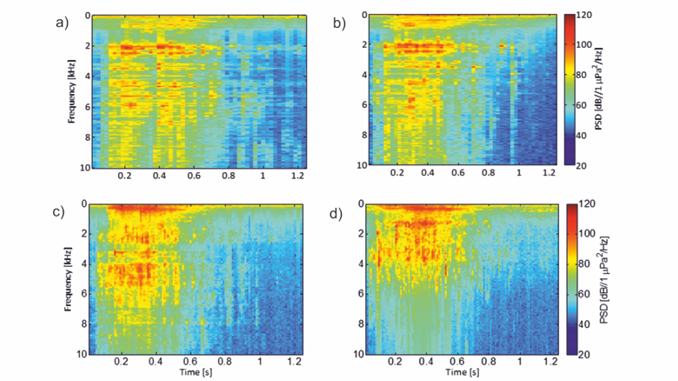
Paper category: Short communication
Corresponding author: Justyna Szuszkiewicz (justyna.szuszkiewicz@ug.edu.pl)
DOI: 10.1515/ohs-2018-0010
Received: 5 July 2017
Accepted: 29 September 2017
Full text: here
Citation (APA style):
Abstract
The breaking wave phenomenon significantly takes part in the mechanisms of mass, heat and gas exchange at the air-water boundary and depends on the wind velocity. Some of the energy dissipated during this process is converted into underwater sound emitted by oscillating gas bubbles and bubble plumes. However, the underwater noise accompanying the lowest wind speed conditions has received only a little attention. This report describes a study aimed at advancing the knowledge of underwater noise emission from air bubbles injected during small-scale breaking events occurring on the water surface. Results of model experiments performed in a small tank are presented. The object of the research is the relationship between the generated noise and the dissipated potential energy of water poured into a tank filled with water of varying physical water properties. Additionally, the impact of various water properties such as salinity, surface tension or microscale gas bubbles was examined. The experiment revealed that noise spectra are affected by different water properties and most likely reflect the varying efficiency of bubble formation and bubble size spectra.
References
Akamatsu, T., Okamura, T., Novarini, N. & Han, H.Y. (2002). Empirical refinements applicable to the recording of fish sounds in small tanks. Journal of the Acoustical Society of America 112(6): 3073–3082. DOI: 10.1121/1.1515799.
Carey, W.M. & Fitzgerald, J.W. (1993). Low frequency noise from breaking waves. In B.R. Kerman (Ed.) Natural Physical Sources of Underwater Sound (pp. 277–304). Springer Netherlands.
Carey, W.M., Fitzgerald, J.W., Monahan, E.C. & Wan, Q. (1993). Measurement of the sound produced by a tipping trough with fresh and salt water. Journal of the Acoustical Society of America. 93(6): 3178–3192. DOI: 10.1121/1.405702.
Deane, G.B. & Stokes, M.D. (2002). Scale dependence of bubble creation mechanisms in breaking waves. Nature 418: 839–844. DOI: 10.1038/nature00967.
Deane, G.B. & Stokes, M.D. (2010). Model calculations of the underwater noise of breaking waves and comparison with experiment. Journal of the Acoustical Society of America 127(6): 3394–3410. DOI: 10.1121/1.3419774.
Detsch, R.M. (1995). Small air bubbles in reagent grade water and seawater: 1. Rise velocities of 20- to 1000-μm-diameter bubbles. Journal of Geophysical Research 96: 8901–8906. DOI: 10.1029/91JC00484.
Han, L. & Yuan, Y. (2007). Bubble size distribution in surface wave breaking entraining process. Science China Earth Sciences 50(11): 1754–1760. DOI: 10.1007/s11430-007-0116-7.
Klusek, Z. & Lisimenka, A. (2013). Acoustic noise generation under plunging breaking waves. Oceanologia 55(4): 809–836. DOI: 10.5697/oc.55-4.809.
Klusek, Z., Dragan, A., Sulisz, W. & Dargacz, A. (2013). Dependence of acoustic noise generation on dissipation energy of plunging waves. In 1st International Conference and Exhibition on Underwater Acoustics, 23–26 June 2013 (pp. 951–956). Corfu, Greece.
Knudsen, V.O., Alford, R.S. & Emling, J.W. (1948). Underwater ambient noise. Journal of Marine Research 7: 410–429.
Kolaini, A.R., Roy, R.A. & Crum, L.A. (1991). An investigation of the acoustic emissions from a bubble plume. Journal of the Acoustical Society of America. 89(5): 2452–2455. DOI: 10.1121/1.400931.
Kolaini, A.R. & Crum, L.A. (1994). Observations of underwater sound from laboratory breaking waves and the implications concerning ambient noise in the ocean. Journal of the Acoustical Society of America 96(3): 1755–1765. DOI: 10.1121/1.410254.
Kolaini, A.R. (1998). Sound radiation by various types of laboratory breaking waves in fresh and salt water. Journal of the Acoustical Society of America 103(1): 300–308. DOI: 10.1121/1.421115.
Leifer, I., Patro, R.K. & Bowyer, P. (2000). A Study on the Temperature Variation of Rise Velocity for Large Clean Bubbles. Journal of Atmospheric and Oceanic Technology 17(10): 1392–1402. DOI: 10.1175/1520-0426(2000)017<1392:ASOTTV>2.0.CO;2.
Leighton, T.G., White, R.R., Morfey, C.L., Clarke, J.W., Heald, G.J. et al. (2002). The effect of reverberation on the damping of bubbles. Journal of the Acoustical Society of America 112(4): 1366–1376. DOI: 10.1121/1.1501895.
Liu, X., & Duncan, J.H. (2003). The effects of surfactants on spilling breaking waves. Nature 421: 520–523. DOI: 10.1038/nature01357.
Loewen, M.R. & Melville, W.K. (1994). An experimental investigation of the collective oscillations of bubble plumes entrained by breaking waves. Journal of the Acoustical Society of America 95(3): 1329–1343. DOI: 10.1121/1.408573.
Means, S.C. & Heitmeyer, R.M. (2002). Surf-generated noise signatures: a comparison of plunging and spilling breakers. Journal of the Acoustical Society of America 112(2): 481–488. DOI: 10.1121/1.1491256.
Medwin, H. & Daniel, A.C. (1990). Acoustical measurements of bubble production by spilling breakers. Journal of the Acoustical Society of America 88(1): 408–4012. DOI: 10.1121/1.399917.
Nicholas, M., Roy, R.A., Crum, L.A., Oguz, H. & Prosperetti, A. (1994). Sound emissions by a laboratory bubble cloud. Journal of the Acoustical Society of America 95(6): 3171–3182. DOI: 10.1121/1.409981.
Orris, G.J. & Nicolas, M. (2000). Collective oscillations of fresh and salt water bubble plumes. Journal of the Acoustical Society of America. 107(2): 771–787. DOI: 10.1121/1.428253.
Stagonas, D., Warbrick, D., Muller, G. & Magagna, D. (2011). Surface tension effects on energy dissipation by small scale, experimental breaking waves. Coastal Engineering 58(9): 826–836. DOI: 10.1016/j.coastaleng.2011.05.009.
Su, M.-Y., Green, A.W. & Bergin, M.T. (1984). Experimental studies of surface wave breaking and air entrainment. In W. Brutsaert & G.H. Jirka (Eds.). Gas transfer at water surfaces (pp. 211–219). Dordrecht: Springer Netherlands.
Su, M.Y., & Cartmill, J. (1995). Effects of salinity on breaking wave generated void fraction and bubble size spectra. In Air-Water Gas Transfer, 24–27 July 1995 (pp. 305–311). Heidelberg University.
Tęgowski, J. (2004). A laboratory study of breaking waves. Oceanologia 46(3): 365–382.
Wenz, G.M. (1962). Acoustic ambient noise in the ocean: spectra and sources. Journal of the Acoustical Society of America 34(12): 1936–1956.
Winkel, E.S., Ceccio, S.L., Dowling, D.R. & Perlin, M. (2004). Bubble-size distributions produced by wall injection of air into flowing freshwater, saltwater and surfactant solutions. Experiments in Fluids 37(6): 802–810. DOI: 10.1007/s00348-004-0850-y.
Yoon, S.W. & Choi, B.K. (1994). Active and passive acoustic roles of bubbles in the ocean. In J.R. Blake, J.M. Boulton-Stone & N.H. Thomas (Eds.), Bubble Dynamics and Interface Phenomena: Proceedings of an IUTAM Symposium Held in Birmingham, United Kingdom, 6–9 September 1993 (pp. 151–160). Dordrecht: Springer Netherlands.

Bądź pierwszy, który skomentuje ten wpis